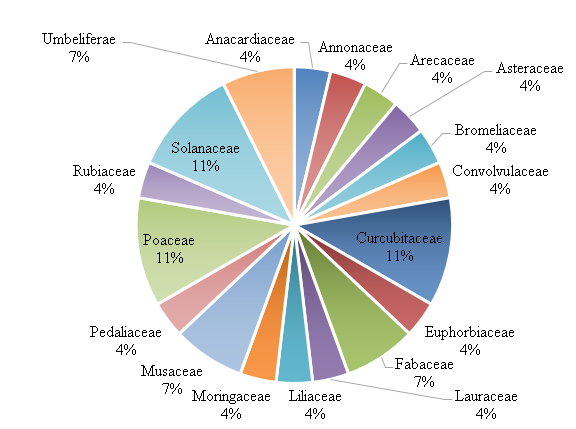Agricultural biodiversity in peasant farms in Granma province
Main Article Content
Abstract
Inventories of agricultural diversity in peasant farms in three municipalities in Granma province, were performed. Species number and area per crop were counted and classified taxonomically. The number of species was determinated by farms, the importance of the species given by the frequency of occurrence in agroecosystems studied. Results indicated that agrobiodiversity of the evaluated properties is represented by 27 species belonging to 17 botanical families. The largest number of managed species was achieved on farms “Bella Luisa” of Guisa municipality and “El Bosque” from Jiguaní with 11 and 10 species respectively. The wealth of species by crop group was dominated by vegetables and fruits. It concluded that diversity of crops of economic importance in the farms are low. The crops in the farm are closely related with basic nutrition, where predominated crops rich in carbohydrates, wilts that the source of vegetal protein is represented only by bean.
Article Details

This work is licensed under a Creative Commons Attribution-NonCommercial 4.0 International License.
Those authors who have publications with this journal accept the following terms of the License Attribution-NonCommercial 4.0 International (CC BY-NC 4.0):
You are free to:
- Share — copy and redistribute the material in any medium or format
- Adapt — remix, transform, and build upon the material
The licensor cannot revoke these freedoms as long as you follow the license terms.
Under the following terms:
- Attribution — You must give appropriate credit, provide a link to the license, and indicate if changes were made. You may do so in any reasonable manner, but not in any way that suggests the licensor endorses you or your use.
- NonCommercial — You may not use the material for commercial purposes.
- No additional restrictions — You may not apply legal terms or technological measures that legally restrict others from doing anything the license permits.
The journal is not responsible for the opinions and concepts expressed in the works, they are the sole responsibility of the authors. The Editor, with the assistance of the Editorial Committee, reserves the right to suggest or request advisable or necessary modifications. They are accepted to publish original scientific papers, research results of interest that have not been published or sent to another journal for the same purpose.
The mention of trademarks of equipment, instruments or specific materials is for identification purposes, and there is no promotional commitment in relation to them, neither by the authors nor by the publisher.
References
Gutiérrez MG, Magaña MA, Zizumbo D, Ballina H. Diversidad agrícola y seguridad alimentaria nutricional en dos localidades Mayas de Yucatán. Acta Universitaria. 2019; 29: 1-14. e1996. doi:http://doi.org/10.15174/au.2019.19961-14.
Singh I, Chand J, Yadav R, Pal, S. Mainstreaming agricultural biodiversity in traditional production landscapes for sustainabledevelopment: the indian scenario. Sustainability. 2020; 12: 10690; doi:10.3390/su122410690.
Browne P, Morejón M, Bonilla, M. Agrodiversidad en la cooperativa de Cayon-Phillips. Revista Cubana de Ciencias Forestales. 2016; 4(1): 91-101.
González G, Leyva A, Pino, O, Mercadet A, Antoniolli Z, Arébalo RA, et al. El funcionamiento de un agroecosistema premontañoso y su orientación prospectiva hacia la sostenibilidad: rol de la agrobiodiversidad. Cultivos Tropicales. 2018; 39(1): 21-34.
Peano C, Caron S, Mahfoudhi M, Zammel K, Zaidi H, Sottile F. A participatory agrobiodiversity conservation approach in the oases: community actions for the promotion of sustainable development in fragile áreas. Diversity. 2021; 13: 253.
https://doi.org/10.3390/d13060253.
Agovino M, Casaccia M, Ciommi M, Ferrara M, Marchesano K. Agriculture, climate change and sustainability: The case of EU-28’. Ecological Indicators. 2018; 105: 525-543. doi:10.1016/j.ecolind.2018.04.064
Bergel SD. La agrobiodiversidad como tema bioético. Alegatos. 2017; 96: 349-364.
Ortiz R, de la Fe CF. Herramientas más utilizadas por el Programa de Innovación Agropecuaria local para diseminar la biodiversidad agrícola. En: La biodiversidad agrícola en manos del campesinado cubano. Instituto Nacional de Ciencias Agrícolas, 2013. Mayabeque, Cuba.
Lores A, Leiva A, Tejeda, T. Evaluación espacial y temporal de la agrobiodiversidad en los sistemas campesinos de la comunidad Zaragoza en la Habana. Cultivos Tropicales. 2008; 29(1): 5-10.
Vázquez L, Matienzo Y, Griffon D. Diagnóstico participativo de la biodiversidad en fincas en transición agroecológica. Fitosanidad. 2014; 18(3):151-162.
Leyva Á, Lores A. Assessing agroecosystem sustainability in Cuba: A new agrobiodiversity index. Elem. Sci Anth. 2018; 6(1): 80. doi: http://doi.org/10.1525/elementa.336
Goulart F, Leyva A, Nelson E, Soares B. Conservation lessons from Cuba: Connecting science and policy. Biological Conservation. 2018; 217: 280-288.
Castiñeiras L. 2006. Conservación in situ de la biodiversidad agrícola en huertos caseros de tres áreas rurales de Cuba. En: Biodiversidad agrícola en las Reservas de la Biosfera de Cuba. La Habana: Academia. p. 296.
Mateos L, Castillo F, Chávez JL, Estrada JA, Livera, M. Manejo y aprovechamiento de la agrobiodiversidad en el sistema milpa del sureste de México. Acta Agron. 2018; 65(4): 413-421. doi: http://dx.doi.org/10.15446/acag.v65n4.50984.
Villa D, García N. Plantas alimenticias en huertas familiares del Magdalena Medio de Colombia. Caldasia. 2017; 39(2): 292-309. Doi: https://dx.doi.org/10.15446/caldasiav39n2263661.
Gutiérrez E, Soto, R, Castellanos L, Gutiérrez C, Osorio GE. Indicadores de biodiversidad de los frutales de unidades de producción agrícola de la Región Central de Cuba. Centro Agrícola. 2014; 41(4):79-85.
Padrón, W. R. Fincas Agroforestales. Programa de diseminación de tecnologías apropiadas para la innovación y el desarrollo agropecuario sostenible. Cienfuegos, Cuba, 2010.
Salmón YL, Martín O, Comas J, Bermúdez A, Gonzales M. Valoración del desarrollo y perspectivas de la agroecología en Cuba. La Habana: Editorial Universitaria. 2017. ISBN 978-959-16-3268-5. 44 pág.
